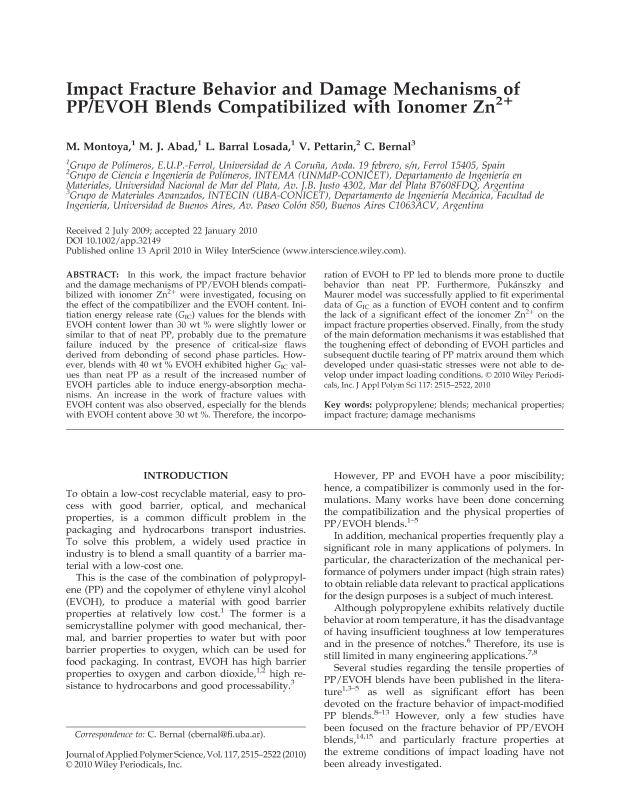Mostrar el registro sencillo del ítem
dc.contributor.author
Montoya, M.
dc.contributor.author
Abad, M. J.
dc.contributor.author
Barral Losada, L.
dc.contributor.author
Pettarin, Valeria

dc.contributor.author
Bernal, Celina Raquel

dc.date.available
2017-04-03T21:32:06Z
dc.date.issued
2010-09
dc.identifier.citation
Montoya, M.; Abad, M. J.; Barral Losada, L.; Pettarin, Valeria; Bernal, Celina Raquel; Impact fracture behavior and damage mechanisms of PP/EVOH blends compatibilized with ionomer Zn2+; Wiley; Journal of Applied Polymer Science; 117; 5; 9-2010; 2515-2522
dc.identifier.issn
0021-8995
dc.identifier.uri
http://hdl.handle.net/11336/14768
dc.description.abstract
In this work, the impact fracture behavior and the damage mechanisms of PP/EVOH blends compatibilized with ionomer Zn2+ were investigated, focusing on the effect of the compatibilizer and the EVOH content. Initiation energy release rate (GIC) values for the blends with EVOH content lower than 30 wt % were slightly lower or similar to that of neat PP, probably due to the premature failure induced by the presence of critical-size flaws derived from debonding of second phase particles. However, blends with 40 wt % EVOH exhibited higher GIC values than neat PP as a result of the increased number of EVOH particles able to induce energy-absorption mechanisms. An increase in the work of fracture values with EVOH content was also observed, especially for the blends with EVOH content above 30 wt %. Therefore, the incorporation of EVOH to PP led to blends more prone to ductile behavior than neat PP. Furthermore, Pukánszky and Maurer model was successfully applied to fit experimental data of GIC as a function of EVOH content and to confirm the lack of a significant effect of the ionomer Zn2+ on the impact fracture properties observed. Finally, from the study of the main deformation mechanisms it was established that the toughening effect of debonding of EVOH particles and subsequent ductile tearing of PP matrix around them which developed under quasi-static stresses were not able to develop under impact loading conditions.
dc.format
application/pdf
dc.language.iso
eng
dc.publisher
Wiley

dc.rights
info:eu-repo/semantics/openAccess
dc.rights.uri
https://creativecommons.org/licenses/by-nc-sa/2.5/ar/
dc.subject
Poly(Propylene) Blends
dc.subject
Mechanical Properties
dc.subject
Impact Fracture
dc.subject
Damage Mechanisms
dc.subject.classification
Ingeniería de los Materiales

dc.subject.classification
Ingeniería de los Materiales

dc.subject.classification
INGENIERÍAS Y TECNOLOGÍAS

dc.title
Impact fracture behavior and damage mechanisms of PP/EVOH blends compatibilized with ionomer Zn2+
dc.type
info:eu-repo/semantics/article
dc.type
info:ar-repo/semantics/artículo
dc.type
info:eu-repo/semantics/publishedVersion
dc.date.updated
2017-04-03T17:29:21Z
dc.identifier.eissn
1097-4628
dc.journal.volume
117
dc.journal.number
5
dc.journal.pagination
2515-2522
dc.journal.pais
Estados Unidos

dc.journal.ciudad
Hoboken
dc.description.fil
Fil: Montoya, M.. Universidad da Coruña; España
dc.description.fil
Fil: Abad, M. J.. Universidad da Coruña; España
dc.description.fil
Fil: Barral Losada, L.. Universidad da Coruña; España
dc.description.fil
Fil: Pettarin, Valeria. Consejo Nacional de Investigaciones Científicas y Técnicas. Centro Científico Tecnológico Mar del Plata. Instituto de Investigación en Ciencia y Tecnología de Materiales (i); Argentina. Universidad Nacional de Mar del Plata; Argentina
dc.description.fil
Fil: Bernal, Celina Raquel. Consejo Nacional de Investigaciones Científicas y Técnicas. Oficina de Coordinación Administrativa Houssay. Instituto de Tecnologías y Ciencias de la Ingeniería; Argentina; Argentina. Universidad de Buenos Aires. Facultad de Ingeniería. Departamento de Ingeniería Mecánica. Grupo de Materiales Avanzados; Argentina
dc.journal.title
Journal of Applied Polymer Science

dc.relation.alternativeid
info:eu-repo/semantics/altIdentifier/url/http://onlinelibrary.wiley.com/doi/10.1002/app.32149/abstract
dc.relation.alternativeid
info:eu-repo/semantics/altIdentifier/doi/http://dx.doi.org/10.1002/app.32149
Archivos asociados
